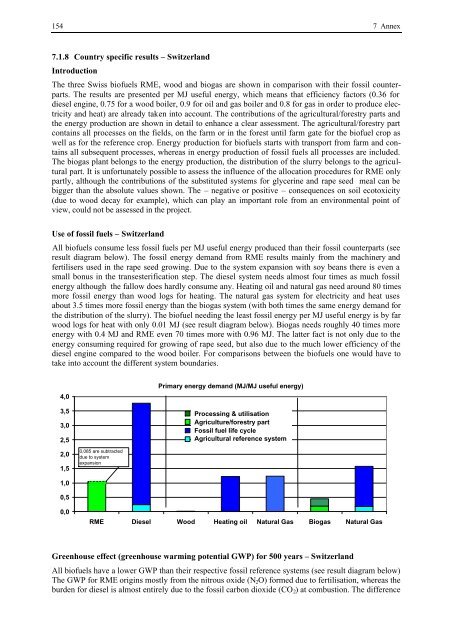BIOENERGY FOR EUROPE: WHICH ONES FIT BEST?
BIOENERGY FOR EUROPE: WHICH ONES FIT BEST?
BIOENERGY FOR EUROPE: WHICH ONES FIT BEST?
You also want an ePaper? Increase the reach of your titles
YUMPU automatically turns print PDFs into web optimized ePapers that Google loves.
154 7 Annex<br />
7.1.8 Country specific results – Switzerland<br />
Introduction<br />
The three Swiss biofuels RME, wood and biogas are shown in comparison with their fossil counterparts.<br />
The results are presented per MJ useful energy, which means that efficiency factors (0.36 for<br />
diesel engine, 0.75 for a wood boiler, 0.9 for oil and gas boiler and 0.8 for gas in order to produce electricity<br />
and heat) are already taken into account. The contributions of the agricultural/forestry parts and<br />
the energy production are shown in detail to enhance a clear assessment. The agricultural/forestry part<br />
contains all processes on the fields, on the farm or in the forest until farm gate for the biofuel crop as<br />
well as for the reference crop. Energy production for biofuels starts with transport from farm and contains<br />
all subsequent processes, whereas in energy production of fossil fuels all processes are included.<br />
The biogas plant belongs to the energy production, the distribution of the slurry belongs to the agricultural<br />
part. It is unfortunately possible to assess the influence of the allocation procedures for RME only<br />
partly, although the contributions of the substituted systems for glycerine and rape seed meal can be<br />
bigger than the absolute values shown. The – negative or positive – consequences on soil ecotoxicity<br />
(due to wood decay for example), which can play an important role from an environmental point of<br />
view, could not be assessed in the project.<br />
Use of fossil fuels – Switzerland<br />
All biofuels consume less fossil fuels per MJ useful energy produced than their fossil counterparts (see<br />
result diagram below). The fossil energy demand from RME results mainly from the machinery and<br />
fertilisers used in the rape seed growing. Due to the system expansion with soy beans there is even a<br />
small bonus in the transesterification step. The diesel system needs almost four times as much fossil<br />
energy although the fallow does hardly consume any. Heating oil and natural gas need around 80 times<br />
more fossil energy than wood logs for heating. The natural gas system for electricity and heat uses<br />
about 3.5 times more fossil energy than the biogas system (with both times the same energy demand for<br />
the distribution of the slurry). The biofuel needing the least fossil energy per MJ useful energy is by far<br />
wood logs for heat with only 0.01 MJ (see result diagram below). Biogas needs roughly 40 times more<br />
energy with 0.4 MJ and RME even 70 times more with 0.96 MJ. The latter fact is not only due to the<br />
energy consuming required for growing of rape seed, but also due to the much lower efficiency of the<br />
diesel engine compared to the wood boiler. For comparisons between the biofuels one would have to<br />
take into account the different system boundaries.<br />
4,0<br />
3,5<br />
3,0<br />
2,5<br />
2,0<br />
1,5<br />
1,0<br />
0,5<br />
0,0<br />
0,085 are subtracted<br />
due to system<br />
expansion<br />
Primary energy demand (MJ/MJ useful energy)<br />
Processing & utilisation<br />
Agriculture/forestry part<br />
Fossil fuel life cycle<br />
Agricultural reference system<br />
RME Diesel Wood Heating oil Natural Gas Biogas Natural Gas<br />
Greenhouse effect (greenhouse warming potential GWP) for 500 years – Switzerland<br />
All biofuels have a lower GWP than their respective fossil reference systems (see result diagram below)<br />
The GWP for RME origins mostly from the nitrous oxide (N2O) formed due to fertilisation, whereas the<br />
burden for diesel is almost entirely due to the fossil carbon dioxide (CO2) at combustion. The difference

















